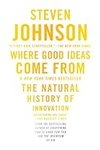
Where Good Ideas Come From

It was an environment that encouraged people to think broadly and generally about task problems, and one in which inquisitive kids felt free to follow their curiosity. Equally important, it was an environment wherein kids, with an initial success, could turn to colleagues who were broadly expert in relevant fields, and particularly because of the
... See moreSteven Johnson • Where Good Ideas Come From
Bhidé, Amar. The Venturesome Economy. Princeton: Princeton University Press, 2008.
Steven Johnson • Where Good Ideas Come From
Those shared environments often take the form of a real-world public space, what the sociologist Ray Oldenburg famously called the “third place,” a connective environment distinct from the more insular world of home or office. The eighteenth-century English coffeehouse fertilized countless Enlightenment-era innovations;
Steven Johnson • Where Good Ideas Come From
Edward O. Wilson’s Consilience
Steven Johnson • Where Good Ideas Come From
Kelly, Kevin. Out of Control. New York: Addison-Wesley, 1994.
Steven Johnson • Where Good Ideas Come From
Legendary innovators like Franklin, Snow, and Darwin all possess some common intellectual qualities—a certain quickness of mind, unbounded curiosity—but they also share one other defining attribute. They have a lot of hobbies.
Steven Johnson • Where Good Ideas Come From
the history of cultural progress is, almost without exception, a story of one door leading to another door, exploring the palace one room at a time.
Steven Johnson • Where Good Ideas Come From
This is not the wisdom of the crowd, but the wisdom of someone in the crowd. It’s not that the network itself is smart; it’s that the individuals get smarter because they’re connected to the network.
Steven Johnson • Where Good Ideas Come From
it is not merely that weak ties allow information to travel throughout a network more efficiently—that is, without becoming trapped on the remote island of a close-knit group. From the perspective of innovation, it’s even more important that the information arriving from one of those weak ties is coming from a different context, what the innovation
... See more